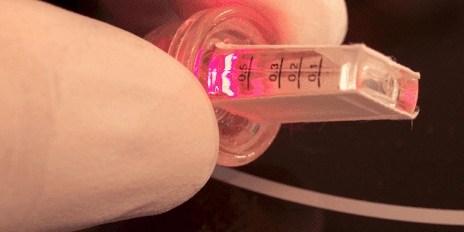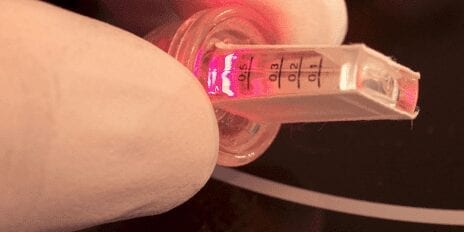
ETH researchers led by Professor Martin Fussenegger have developed the first gene network to be operated via brainwaves.
Depending on the user’s thoughts, it can produce various amounts of a desired molecule. The inspiration behind the project was a game that picks up brainwaves in order to guide a ball through an obstacle course.
It sounds like something from the scene in Star Wars where Master Yoda instructs the young Luke Skywalker to use the force to release his stricken X-Wing from the swamp: Marc Folcher and other researchers from the group led by Martin Fussenegger, Professor of Biotechnology and Bioengineering at the Department of Biosystems (D-BSSE) in Basel, have developed a novel gene regulation method that enables thought-specific brainwaves to control the conversion of genes into proteins – called gene expression in technical terms.
“For the first time, we have been able to tap into human brainwaves, transfer them wirelessly to a gene network and regulate the expression of a gene depending on the type of thought. Being able to control gene expression via the power of thought is a dream that we’ve been chasing for over a decade,” says Fussenegger.
A source of inspiration for the new thought-controlled gene regulation system was the game Mindflex, where the player wears a special headset with a sensor on the forehead that records brainwaves. The registered electroencephalogram (EEG) is then transferred into the playing environment. The EEG controls a fan that enables a small ball to be thought-guided through an obstacle course.
Wireless transmission to implant
The system, which the Basel-based bioengineers recently presented in the journal Nature Communications, also makes use of an EEG headset. The recorded brainwaves are analysed and wirelessly transmitted via Bluetooth to a controller, which in turn controls a field generator that generates an electromagnetic field; this supplies an implant with an induction current.
A light then literally goes on in the implant: an integrated LED lamp that emits light in the near-infrared range turns on and illuminates a culture chamber containing genetically modified cells. When the near-infrared light illuminates the cells, they start to produce the desired protein.
The Latest on: Gene expression
[google_news title=”” keyword=”gene expression” num_posts=”10″ blurb_length=”0″ show_thumb=”left”]
via Google News
The Latest on: Gene expression
- Poseida Highlights Strong Progress on Its Genetic Medicine Programs at the American Society for Gene and Cell Therapy 27th Annual Meetingon May 9, 2024 at 7:18 am
NDAQ:PSTX) Poseida Highlights Strong Progress on Its Genetic Medicine Programs at the American Society for Gene and Cell Therapy 27th Annual Meeting ...
- ASGCT 2024: Kate Therapeutics Unveils Gene Therapy Platform and Product Pipeline Progresson May 9, 2024 at 7:00 am
KateTx debuted less than a year ago with a $51 million Series A round co-led by Westlake Village BioPartners and Versant Ventures.
- Editas Medicine’s Innovative In Vivo Gene Editing Approach and Positive Clinical Trial Prospects Bolster Buy Ratingon May 9, 2024 at 3:26 am
Editas Medicine (EDIT – Research Report), the Healthcare sector company, was revisited by a Wall Street analyst yesterday. Analyst ...
- Interferon beta corrects gene processing disrupted in MS: Studyon May 8, 2024 at 10:01 pm
Interferon beta corrected defects in a process known as alternative splicing, which is disrupted in MS, a study found.
- Team develops an epigenome editing toolkit to dissect the mechanisms of gene regulationon May 8, 2024 at 5:00 pm
By combining this data with gene expression analysis and the known effects of perturbing specific genes, scientists have ascribed functions to such chromatin marks. However, the causal relationship ...
- Pharming Group uproots angioedema gene therapy collab with Orchardon May 7, 2024 at 11:15 pm
Hopes for OTL-105 rested on preclinical studies that the companies said at the time “demonstrated high levels of SERPING1 gene expression via lentiviral-mediated transduction in multiple cell lines ...
- EUROBIO SCIENTIFIC SIGNS AN AGREEMENT TO ACQUIRE GENE EXPRESSION TEST FOR BREAST CANCER ENDOPREDICT®on May 7, 2024 at 9:31 am
EUROBIO SCIENTIFIC SIGNS AN AGREEMENT TO ACQUIRE GENE EXPRESSION TEST FOR BREAST CANCER ENDOPREDICT® Expansion in the oncology segmentDevelopment of Eurobio Scientific proprietary product ...
- Gene modules linked to both depression and cardiovascular diseases identifiedon May 5, 2024 at 2:41 am
It can provide new joint biomarkers for depression and CVD, leading to the development of treatments simultaneously targeting the two.
- Investigational FSHD Drug Did Little to Change DUX4 Expressionon May 2, 2024 at 12:32 pm
The investigational drug losmapimod did not significantly change expression of the gene behind facioscapulohumeral muscular dystrophy (FSHD), but it was associated with potential ...
- Methods To Alter Cellular Gene Expressionon May 1, 2024 at 6:03 am
protamine offers a potential solution to achieving high levels of gene expression in target tissues, which is necessary for effective cancer treatment. However, while protamine is a valuable gene ...
via Bing News











